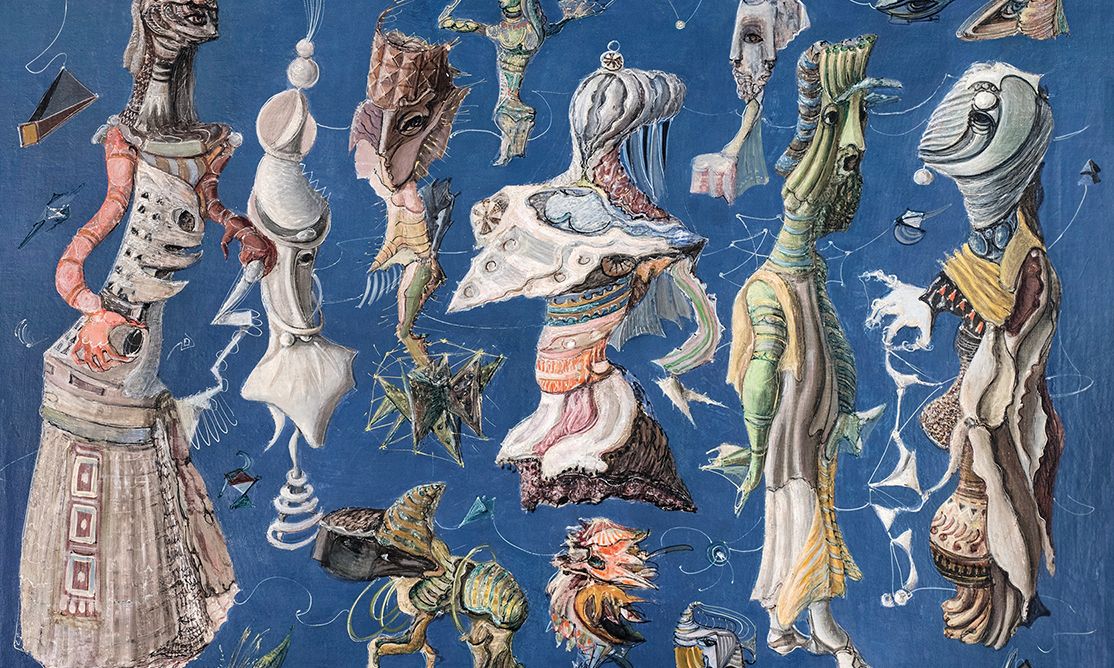Suzanne van Damme’s Surreal Composition (1943) © Collection RAW (Rediscovering Art by Women)
When André Breton sat down in 1924 to pen the preface to his book of poems Poisson Soluble, he had no intention of writing a manifesto. He just had some things to say about the ideas underpinning his process. And yet, those 21 slim pages, full of scratchings out and notes glued in, launched a movement so indelible, some hold that it has never gone away.
This month, the Centre Pompidou in Paris launches the centennial celebrations of that moment with a comprehensive survey, titled simply Surrealism. In 13 thematic chapters, the exhibition will chart the four decades of the Surrealist movement proper, from 1924 to its official dissolution in 1969, as declared by the author Jean Schuster in the French newspaper Le Monde.
A page from André Breton's Surrealist manifesto from 1924 © BnF, Paris; Adagp, Paris, 2024
“Surrealism wasn’t a formalism,” says Marie Sarré, the curator of Modern collections at the Centre Pompidou. “It was a collective adventure, a philosophy, you might say, that lasted for 40 years, if indeed it ever ended. It was incredibly vibrant, constantly reinventing itself.”
In the 1950s and 1960s, there were still new Surrealists emerging, producing art just as extraordinary as that of the 1920s. And even after 1969, artists who ascribed to the movement insisted they were making Surrealist work, despite the demise of the founding theoretician that was Breton. Surrealism was always bigger than one person.
The Pompidou show is organised in a spiralling labyrinth that echoes Marcel Duchamp’s staging of the 1947 international exhibition of Surrealism at Galerie Maeght in Paris. Visitors will enter it through a monstrous sculpted portal reminiscent of the entrance to the erstwhile Cabaret de l’Enfer (the cabaret of hell), a few steps away from Breton’s studio on the Rue Fontaine. Thanks to the magician Abdul Alafrez, people will then appear to disappear down a corridor, only to emerge in a central hub where Breton’s original manuscript will be on display.
Not many people have had the chance to see this handwritten document, on loan from the Bibliothèque Nationale de France. And, as Sarré notes, few actually know what it says: “Even among insiders, who might otherwise quote manifestos including that of Futurism, people don’t really have Breton’s text in mind. And yet when you hear it, it really stays with you. You realise how current it is.” To that end, the curatorial team has worked with the Institute for Research and Coordination in Acoustics/Music, housed next door, to create an AI-generated recording of the author reading it out loud.
Salvador Dalí’s Dream Caused by the Flight of a Bee Around a Pomegranate a Second Before Awakening (1944)
© Museo Nacional Thyssen-Bornemisza
This literary grounding of the wider movement sees each successive theme pair a Surrealist tenet (such as the medium, the chimera or the poet) with a method (automatic writing, collage or graft). In place of an audioguide, the museum has commissioned a podcast with actors reciting poems and texts.
As curators, Sarré and the museum’s deputy director Didier Ottinger, have included only those artists who were strictly speaking Surrealists—the names included in the literary reviews and international exhibitions. This of course means masterpieces in every room: Dora Maar’s Untitled (Hand Shell) (1934), Salvador Dalí’s Dream Caused by the Flight of a Bee Around a Pomegranate a Second Before Awakening (1944), and René Magritte’s Empire of Light (1954).
Dora Maar's Untitled (Hand Shell) (1934) © Centre Pompidou, MNAM-CCI/Jacques Faujour/Dist. RMN-GP; Adagp, Paris, 2024
As recent scholarship has amply proven, this also encompasses so many more women than art historians long acknowledged. Among these are the English all-rounder Edith Rimmington, the Belgian painter Suzanne van Damme, the Spanish artist Remedios Varo and the French poet Gisèle Prassinos. The show will also further disprove the false notion that Surrealism was purely a European affair by spotlighting the likes of the masterful Japanese draughtsman Tatsuo Ikeda and painters such as Helen Lundeberg (from the US) and Rufino Tamayo (from Mexico).
Sarré highlights the movement’s progressive outlook and political positioning. “Considering how old-fashioned and conservative people found it for so long, Surrealism is an extremely modern movement.” Its rebuttal of Western enlightenment values, its anticolonial drive and the urgent need it embodied to reinvent our relationship to the universe and to nature, she says, were groundbreaking for the 1920s. Surrealism stood in opposition to the other avant-gardes of the era, which so often cleaved to mechanisation and industrialisation as forms of progress.
Surrealist exhibitions were the smash hits of their day, drawing in thousands of viewers. Younger generations today might not know about the movement, but as Sarré puts it, many certainly share its values. “Gen Zs too are disillusioned with the idea of progress and Modernism, they’re politically and ecologically engaged, anticolonialist, antinationalist—in a way that chimes with what the Surrealists were doing.”
• Surrealism, Centre Pompidou, Paris, 4 September-13 January 2025

